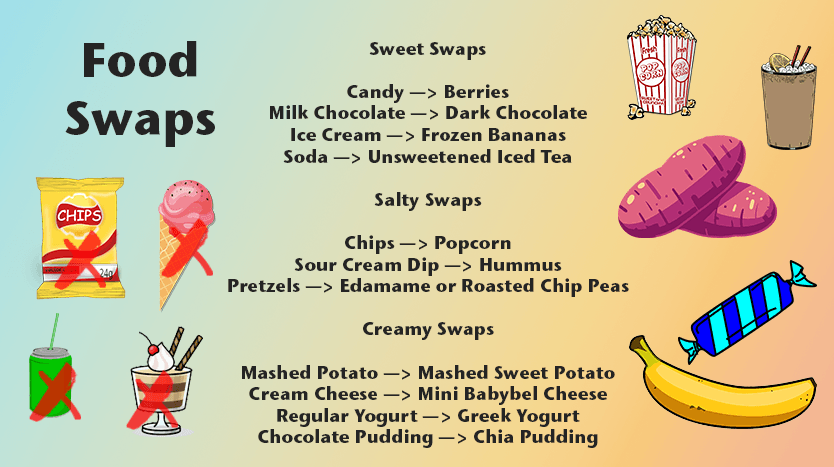
Welcome to the Positive Pulse blog! Check in with us each month for tips on healthy living, right on our website. A short snippet will be featured in the NJSAP monthly newsletter as well, which you can sign up for here.
This months topic is food substitutions! Food can be a confusing topic if you’re inexperienced in the kitchen. And even veteran chefs may want to break away from old habits on occasion, especially if you are looking to make a healthy change. We’re going to tackle some basic items you can swap when cooking and baking, whether for improving your dietary health or for convenience.
Here are some health food swap ideas, depending on what you are craving!
General Swaps
- Jam —> Smashed Avocado
- Egg Whites —> Whole Eggs
- Creamer —> Organic Whole Milk
- Bagels —> English Muffins
- Mayo —> Hummus
- Rice —> Grated Cauliflower
- Sour Cream —> Greek Yogurt
Sweet Swaps
- Candy —> Berries
- Milk Chocolate —> Dark Chocolate
- Ice Cream —> Frozen Bananas
- Soda —> Unsweetened Iced Tea
Salty Swaps
- Chips —> Popcorn
- Sour Cream Dip —> Hummus
- Pretzels —> Edamame or Roasted Chip Peas
Creamy Swaps
- Mashed Potato —> Mashed Sweet Potato
- Cream Cheese —> Mini Babybel Cheese
- Regular Yogurt —> Greek Yogurt
- Chocolate Pudding —> Chia Pudding
Sometimes you are cooking and you think you have everything set, and oh no- that carton of eggs is actually empty upon closer inspection! Or perhaps you can’t make it to the store for some heavy whipping cream, which you don’t usually have on hand. The following items can be swapped in for a close match in your recipe to save your meal. You can find even more here.
- Baking Powder (double-acting): For 1 teaspoon, combine ½ teaspoon cream of tartar and ¼ teaspoon baking soda.
- Baking Soda: For 1 teaspoon, use 3 teaspoons baking powder.
- Butter: All baking: Greek yogurt, applesauce or oil. Non-baking: Canola oil, vegetable oil, olive oil, coconut oil or ghee.
- Buttermilk: All baking: For 1 cup, combine 1 cup whole, low-fat or skim milk and 1 tablespoon lemon juice or white distilled or white wine vinegar. Non-baking such as mashed potatoes and salad or slaw dressings: Combine plain yogurt, sour cream or kefir with enough milk or water to create a pourable heavy-cream consistency.
- Eggs: Best for all baking and batters (example: pancakes): For 1 egg, use 3 tablespoons aquafaba (the viscous liquid from canned beans; chickpea aquafaba is preferred.) Best for muffins, quick breads and cakes: For 1 egg, combine 3 tablespoons vegetable oil and 1 tablespoon water. Alternatively, use ¼ cup applesauce, ¼ cup pureed silken tofu or ¼ cup canned pumpkin for every whole egg needed. (Homemade alternatives are not appropriate for omelets, souffles, frittatas and other egg-heavy dishes.) Egg Whites: For all baking, batters and meringue (except Swiss, Italian and French buttercreams): For 1 egg white, use 2 tablespoons aquafaba (see above). (Homemade alternatives are not appropriate for omelets, souffles, frittatas and other egg-heavy dishes.)
- Half-and-Half: For 1 cup, combine a scant cup whole milk and 1 tablespoon melted butter. Alternatively, combine ¾ cup whole milk and ¼ cup heavy cream.
- Heavy Cream: (Except for whipping) Coconut milk or unsweetened coconut cream.
- Heavy Whipping Cream: (Except for whipping) Half-and-half. Alternatively, for 1 cup, combine ¾ cup milk and 4 tablespoons melted butter.
- Milk: Yogurt or sour cream thinned with water to a pourable consistency.
- Yogurt (Greek and plain): Sour cream or creme fraiche.
RESOURCE: https://www.nurturelife.com/blog/healthy-alternatives-common-foods-better-diet/

